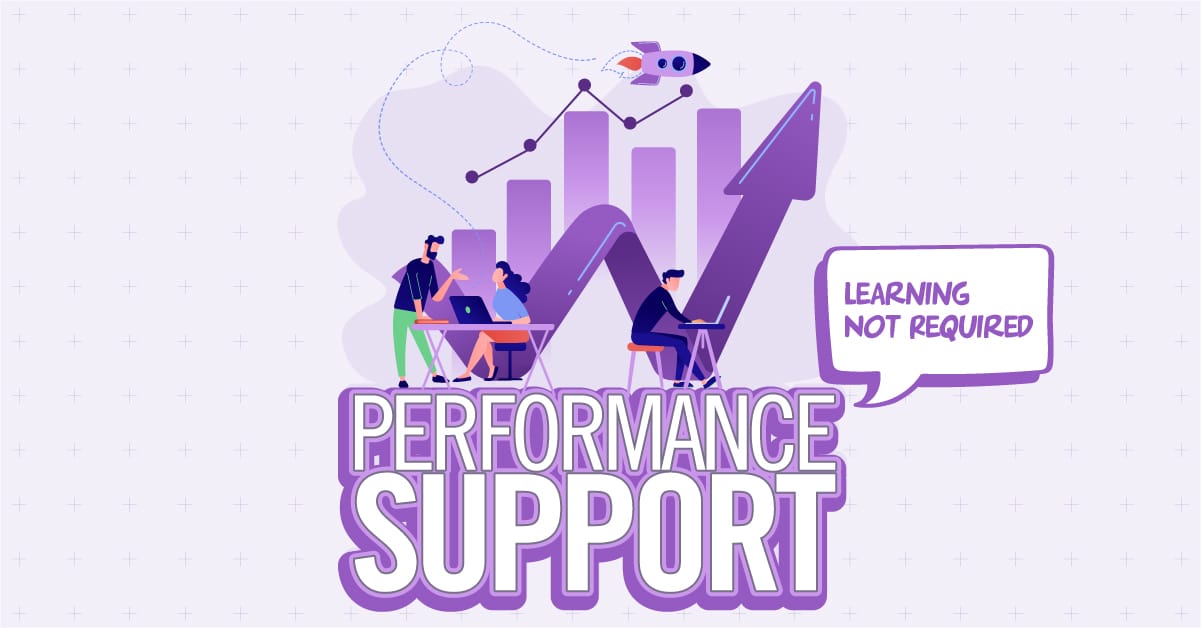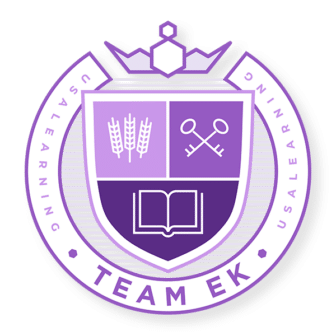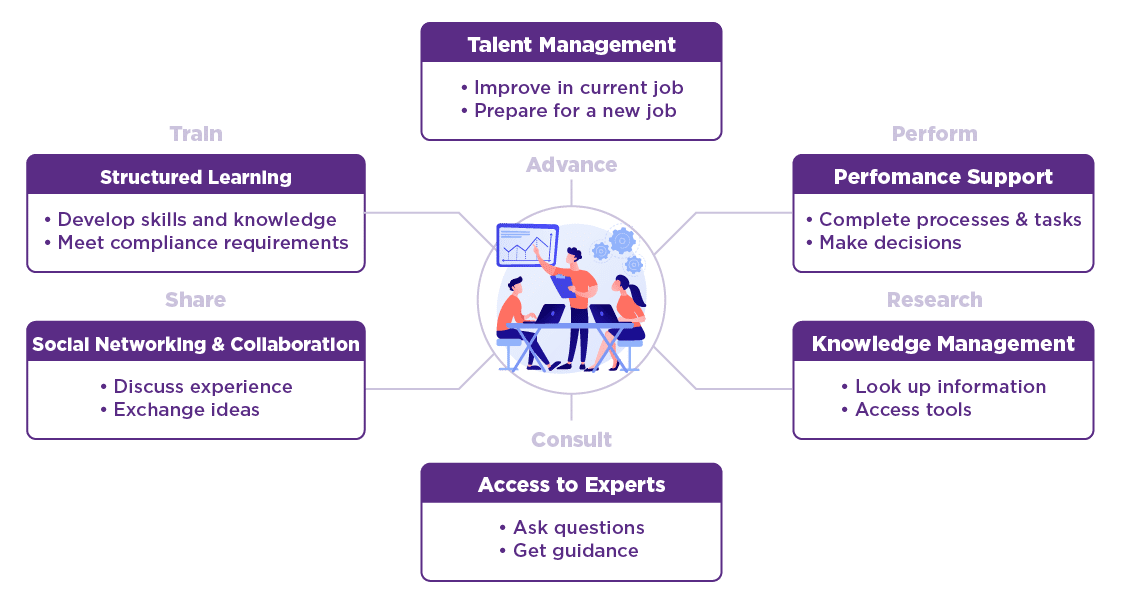Enterprise Knowledge assembled Team EK to deliver advanced learning solutions as part of the USA Learning contract. We’ve invited world-leading subject matter experts to offer guest posts in our Knowledge Base, as part of our ongoing commitment to thought leadership in Learning and Knowledge Management.
A key member of Team EK is InfoMedia Designs. This contribution to our Knowledge Base is authored by Steve Foreman, founder and principal of this Team EK partner.

Sometimes, learning is not the most effective or efficient way to enable human performance.
Genesis of an idea
Thirty years ago, a major influencer in the learning industry named Gloria Gery met daily for several weeks with a handful of people who worked for a multinational communications corporation. The group was charged with advancing a strategy to increase the use of computer technology for employee training. Gloria had written a popular book1 about how to make computer-based training (CBT) happen. CBT was a 1980’s label for elearning.
In those days, many companies had luxurious training centers, often with restaurant service in the “cafeteria” and hotel-like accommodations. Some called themselves corporate universities. Some even had various schools and deans. Being sent to training was like a reward; a sort of vacation from work. The corporate culture was deeply rooted in face-to-face teaching and lecturing. CBT was frowned on. Where was the trip to the training center? How could a computer teach as well as a human?
Gloria and the small group pondered these perceptions and other organizational challenges. After a few days, Gerry Puterbaugh, an instructional technologist, said, “It’s not about training, it’s about performance.” That simple statement led the group’s discussion and planning into an entirely new realm. For Gloria, it led to a new line of consulting work, a groundbreaking book about electronic performance support systems, and an enduring legacy in the field of learning and performance.
What is performance support?
In her book, Gloria Gery defined performance support as “An integrated electronic environment that is available to and easily accessible by each employee and is structured to provide immediate, individualized on-line access to the full range of information, software, guidance, advice and assistance, data, images, tools, and assessment and monitoring systems to permit job performance with minimal support and intervention by others.” 2
Gloria’s definition was visionary and sweeping. Today, we might call Gloria’s “integrated electronic environment” an ecosystem; a supporting framework that places the performer at the center and surround them with 6 key support methods: structured learning, talent management, performance support, knowledge management, access to experts, and social networking and collaboration 3. The performer decides which method(s) to use in a given situation. Ideally, the ecosystem model allows performers to get work done with minimal disruption.
Learning and Performance Ecosystem
Rosenberg and Foreman, 2014
In the ecosystem model, performance support is defined more narrowly as one of the six support methods, rather than ecosystem itself. In the ecosystem context, performance support is focused specifically on providing guidance and assistance with performing discrete tasks.
Performance Support Definition: Performance support is software that enables workers, who may not possess all of the requisite skills and knowledge, to use new tools, complete tasks and processes, and diagnose and solve problems effectively, while remaining immersed in their work 4.
While the entire ecosystem ultimately supports performance, some components are more directed at real-time task support than others. Performance support is the one ecosystem component with an exclusive focus on successful task completion with no prior learning required.
| Ecosystem component | Real-time task support | Not real-time |
|---|---|---|
| Talent management | Plan and measure performance. | |
| Structured learning | OTJ and mentoring involves learning while performing tasks. | Gain skills and knowledge to prepare for performance. |
| Knowledge management | Look something up while performing. | Stay informed. |
| Social networking | Crowdsource answers and share task-related information while performing. | Stay informed, develop professional networks. |
| Access to experts | Get real-time task guidance and assistance with a live person. | Consult with an expert to prepare for performance, or to review prior performance. |
| Performance support | Software-based guidance and assistance for completion of discrete tasks. |
A GPS-enabled map app is a good example of performance support. Map apps enable you to perform (get there) without first learning how (knowing the way). After a few guided trips, you may eventually learn to navigate to your destination without the app. In this way, learning becomes a byproduct of using performance support. However, you do not need to learn before you can perform.
Off-the-shelf performance support products
Now, more than 3 decades after Gloria Gery introduced the concept, performance support has matured into a diverse set of software applications, each with its own commercial market(s).
There are three main categories of commercial performance support platforms:
- Digital adoption platforms assist users of enterprise systems, such as SalesForce, SAP, Oracle, and Microsoft. Features typically appear on top of the enterprise system pages and offer demonstrations, walk-throughs, examples, templates, and wizards. There are many commercial products in this category. Examples: ChurnZero, Pendo, Userpilot, Whatfix, WalkMe.
- Process support and automation tools assist people that need to complete a procedure or process. Typical features include explanations, examples, step-by-step instructions, progress tracking. Some products also offer task automation and robotics features. There are several commercial products in this category. Examples: Google Maps, Intuit TurboTax, Kryon Leo, uPerform.
- Decision support systems assist people who need to analyze inputs and make decisions, often related to problem solving or action planning. It is a software-based expert consultation that collects input, provides a diagnosis, and recommends one or more potential solutions. Features may include structured interviews, calculators, configurators, balanced scorecards, weighted recommendations, and links to relevant resources. These solutions are often custom designed and developed. Many of the commercial products in this category focus on the agriculture, business management, financial, and healthcare industries. Examples: 1000minds, Benefitfocus, RAMPmedical, PERKY.
Building a custom performance support solution
Performance support is not only available in commercial applications. Corporations and government sometimes develop their own custom tools. Here is one example…
A large industrial manufacturing company created a decision support tool to reduce costly problems with inventory management.
Step One: The designers worked with project sponsors to identify key human performance problems areas impacting inventory management, the associated business metrics, and current and target values for each metric. Four problem areas were identified:
| Performance problem | Business impact | Metric |
|---|---|---|
| Forecasting | Inaccurate forecasting resulting in problems with inventory availability and affects production. | Forecast Accuracy |
| Ordering | Too much inventory causes storage and cash flow problems; too little inventory disrupts production. | Days On Hand |
| Counting | Differences between recorded and actual inventory result in problems with inventory availability. | Inventory Accuracy |
| Shipping | Inefficient shipping results in higher costs and lower profit margins. | Freight Costs |
Step Two: Designers worked with subject matter experts (SMEs) to identify the key job roles responsible for inventory forecasting, ordering, counting, and shipping.
Step Three: Designers worked with people in each job role to identify critical work tasks, key challenges impacting accomplishment of those tasks, and relevant human performance metrics.
Step Four: Designers worked with SMEs to capture and codify their problem solving methods. What questions did they ask people in the key job roles to determine the problem? At what point did they have enough information to provide a diagnosis? What solution options did they recommend for each diagnosis?
Step Five: Designers worked with software developers defined and configured rules for an inference engine to emulate the expert problem solving process, including fact-finding dialog, collection of diagnoses, and associated recommendations.
Step Six: The performance support tool was piloted at a handful of plants, tweaked, and then rolled out to all locations.
Step Seven: The project sponsors were engaged to communicate and encourage adoption of the performance support tool by the target audience.
Step Eight: The tool usage and business metrics were monitored to determine the solution’s impact.
Step Nine: The tool was iteratively enhanced and expanded over time to address additional problem areas.
The performance support solution was measurably successful and elevated the developer’s credibility with the project sponsor and other leaders in the organization.
Summary
Problems that are good candidates for performance support solutions are those that cannot be fully addressed by training and require ongoing support because of the high frequency and complexity of performance, high turnover of performers, inefficiency of permanent transfer of skills and knowledge to performers, importance to the organization, and strong sponsorship.
Performance support is a much more direct intervention than training. Rather than interrupting work to take a course, a performance supports solution guides and helps people get work done in real time. Operating in ways similar to an expert consultant, these applications collect input and recommend actions. Effective performance support is focused on solving measurable business problems. Its users are performers, not learners. It is used in the flow of work, not the classroom. It’s goal is “doing” rather than “knowing.” Performance support is direct, effective, and instantly available.
In 1990, Gloria Gery and her small group of clients experienced a fundamental shift in paradigm. Now, more than 3 decades later, that same paradigm shift resonates among forward-looking learning and development professionals. “It’s not about learning, it’s about performance.”
Sources:
- Gloria Gery, Making CBT Happen, Gery Associates, 1987 1
- Gloria Gery, Electronic Performance Support Systems, Weingarten Publications, 1991 2
- Foreman (2010); Rosenberg and Foreman (2014) 3
- Rosenberg and Foreman (2013) 4


